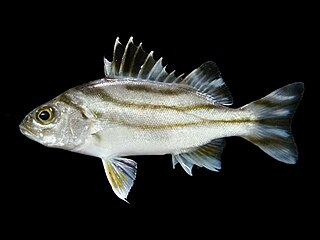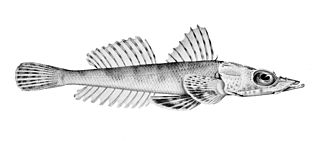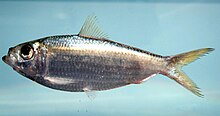
The flagtails are a family (Kuhliidae) of centrarchiform ray-finned fish of the Indo-Pacific area. The family consists of about 12 species in one genus, Kuhlia. Most are euryhaline and often found in brackish water, but the genus also includes species restricted to marine or fresh water.

Grunters or tigerperches are ray-finned fishes in the family Terapontidae. This family is part of the superfamily Percoidea of the order Perciformes.

Dorosoma is a genus that contains five species of shads, within the family Dorosomatidae. The five species are native to the North and/or Central America, and are mostly known from fresh water, though some may reside in the waters of estuaries and bays.

Limnothrissa is a small genus of freshwater ray-finned fishes elonging to the family Dorosomatidae, which also includes the gizzard shads and sardinellas. The species in this genus are endemic to Africa. It was considered to be monospecific but L. strappersi, a Lake Mweru endemic, has been recognised as a valid species. The Lake Tanganyika sardine was endemic to Lake Tanganyika but has been introduced to Lake Kivu, Lake Kariba and the Cahora Bassa reservoir.

Pseudupeneus is a genus of goatfishes native to the Atlantic Ocean and the eastern Pacific Ocean. They inhabit mainly the coastal waters of continental shelves, but can be found in deep waters, as well.
Congresox is a genus of marine ray-finned fishes belonging to the family Muraenesocidae, the pike congers. The fishes in this genus are found in the Indian and Pacific Oceans.

Pristigaster is a small genus of ray-finned fish belonging to the family Pristigasteridae. It contains two species, both restricted to the Amazon Basin in South America.

Amblygaster is a small genus of sardinellas in the herring family Dorosomatidae. It currently contains four species. They are found in Indo-West Pacific regions.

Lile, the piquitingas, is a genus of small fish belonging to the family Dorosomatidae, which includes the gizzard shads and sardinellas. They are endemic to the Americas. There are currently four recognized species in the genus.

Microthrissa is a genus of freshwater ray-finned fishes belonging to the family Dorosomatidae, which also includes the gizzard shads and sardinellas. The species in this genus are endemic to Africa.
Nannothrissa is a genus of very small fish in the herring family, Dorosomatidae, endemic to the Congo River system in Africa. There are currently only two recognized species

Odaxothrissa, the fangtooth pellonulines, is a genus of fresh-water fish in the family Dorosomatidae. There are currently three recognized species in this genus, all of which are found in tropical Africa.
Opisthopterus is a genus of longfin herring in the family Pristigasteridae. There are currently six species in this genus. They are found in Indo-Pacific.

Sorsogona is a genus of flatheads native to the Indian Ocean and the western Pacific Ocean.

Sebastiscus is a genus of marine ray-finned fish belonging to the subfamily Sebastinae part of the family Scorpaenidae. These fishes are native to the western Pacific Ocean. They are collectively called sea ruffes and resemble the rockfishes in the genus Sebastes, but are usually smaller and have a different pattern.
The yellow pike conger is a species of marine ray-finned fish belonging to the family Muraenesocidae, the pike congers. This fish is found in the Indian Ocean and the western Pacific Ocean.

Pentaceros is a genus of marine ray-finned fish, armorheads from the family Pentacerotidae. They are native to the Pacific, Indian, and eastern Atlantic Oceans. Pentaceros is the only genus in the monotypic subfamily Pentacerotinae.

The ara, otherwise known as the saw-edged perch or the Dageumbari (다금바리) is a species of marine ray-finned fish from the monospecific genus Niphon in the monogeneric family Niphonidae. It is found in the Western Pacific Ocean from Japan south to the Philippines where it inhabits rock reefs and inshore waters with rocky sea beds. This species can grow up to 1 metre (3.3 ft) in total length. The ara was first formally described in 1828 by Georges Cuvier in the Histoire naturelle des poissons which he co-authored with Achille Valenciennes, the type locality was given as the Sea of Japan.

Dorosomatidae is a family of clupeiform fishes. It is now recognized by FishBase as a family in its own right; it had been considered to be a subfamily of Clupeidae. It contains 31 extant genera.

Harenngula clupeola, the false herring, false pilchard or red-ear pilchard, is a species of marine ray-finned fish belonging to the family Dorosomatidae, the gizzard shads and sardinellas. The false herring is found in the Western Atlantic Ocean from eastern Florida and the Bahamas through the Gulf of Mexico south to Santa Catarina in Brazil.















